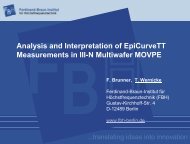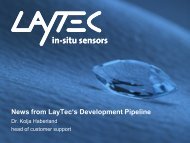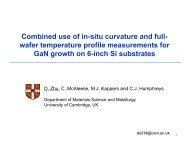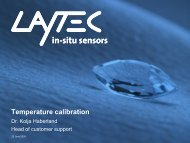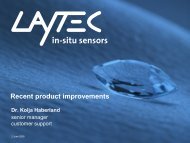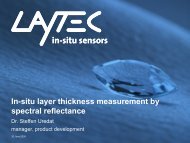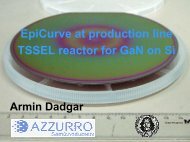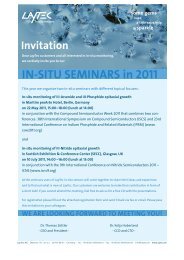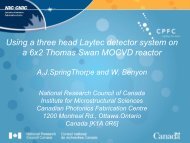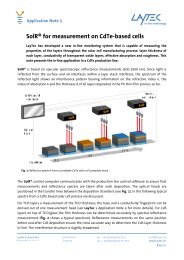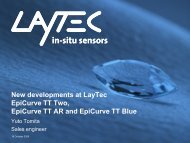Temperature calibration - Laytec
Temperature calibration - Laytec
Temperature calibration - Laytec
You also want an ePaper? Increase the reach of your titles
YUMPU automatically turns print PDFs into web optimized ePapers that Google loves.
<strong>Temperature</strong> <strong>calibration</strong><br />
Dr. Kolja Haberland<br />
Head of customer support<br />
18 October 2009
Outline<br />
• motivation<br />
• pyrometry<br />
• pre-<strong>calibration</strong><br />
• viewports<br />
• <strong>calibration</strong><br />
• solutions<br />
18 October 2009 <strong>Temperature</strong> <strong>calibration</strong> 2
Motivation<br />
Heteroepitaxy of III-Nitride semiconductors<br />
Wafer temperature has influence on:<br />
• material quality<br />
• composition of ternary compounds<br />
• evolving film stress<br />
substrate/wafer<br />
susceptor<br />
Bow<br />
Δz ~ ΔT<br />
Stress due to lattice mismatch results in wafer bowing which leads to:<br />
� Change in temperature uniformity across the wafer<br />
� Inhomogeneity of material properties<br />
18 October 2009 <strong>Temperature</strong> <strong>calibration</strong><br />
3
Motivation: temperature effects<br />
Vertical temperature profile of a III-N reactor<br />
2...20K<br />
20...50K<br />
>300K<br />
temperature<br />
vertical position in reactor<br />
reactor upper boundary<br />
gas<br />
wafer<br />
satellite susceptor<br />
main susceptor<br />
heater<br />
18 October 2009 <strong>Temperature</strong> <strong>calibration</strong><br />
4
Motivation: temperature effects<br />
<strong>Temperature</strong> access in III-N processes<br />
EpiCurve, Pyro400 (T wafer)<br />
EpiTT, EpiCurveTT (T pocket)<br />
thermo couple,<br />
light pipe<br />
reactor upper boundary<br />
wafer<br />
satellite susceptor<br />
main susceptor<br />
heater<br />
gas<br />
18 October 2009 <strong>Temperature</strong> <strong>calibration</strong><br />
5
Motivation<br />
<strong>Temperature</strong> <strong>calibration</strong><br />
• temperature is most important growth parameter<br />
• themocouple or light pipe temperature used to control<br />
reactor temperature in recipe have high offsets to pocket<br />
and wafer temperature<br />
• temperature measurement might be influenced by<br />
viewport geometry and window transparency<br />
� proper and accurate <strong>calibration</strong> of the EpiTT/EpiCurve<br />
pyrometer is essential<br />
18 October 2009 <strong>Temperature</strong> <strong>calibration</strong><br />
6
Outline<br />
• motivation<br />
• pyrometry<br />
• pre-<strong>calibration</strong><br />
• viewports<br />
• <strong>calibration</strong><br />
• solutions<br />
18 October 2009 <strong>Temperature</strong> <strong>calibration</strong> 7
Pyrometry<br />
Principle of pyrometry<br />
infra red visual ultra violet<br />
Planck's equation:<br />
intensity of emission or<br />
incandescence from heated<br />
black body is correlated to<br />
its temperature<br />
But emission of real body (wafer)<br />
is different from black body, so<br />
emissivity ε has to be determined<br />
M. Planck, Verh. Dtsch. phys. Ges. Berlin, 2 (1900) 202 and 2 (1900) 237.<br />
18 October 2009 <strong>Temperature</strong> <strong>calibration</strong><br />
8
Pyrometry<br />
Emissivity Corrected Pyrometry<br />
thermal emission and reflectance measured simultaneously at 950nm<br />
emissivity corrected temperature<br />
conservation of energy:<br />
α + r + t = 1<br />
opaque semiconductor:<br />
α + r = 1<br />
Kirchhoffs Law<br />
α (λ,T) = ε (λ,T)<br />
⇒ ε = 1 – r<br />
measure r and correct<br />
for changes of ε<br />
18 October 2009 <strong>Temperature</strong> <strong>calibration</strong><br />
9<br />
H. Grothe and F.G. Böbel, J. Cryst. Growth 127 (1993) 1010.
Outline<br />
• motivation<br />
• pyrometry<br />
• pre-<strong>calibration</strong><br />
• viewports<br />
• <strong>calibration</strong><br />
• solutions<br />
18 October 2009 <strong>Temperature</strong> <strong>calibration</strong> 10
Pre-<strong>calibration</strong><br />
Factory pre-<strong>calibration</strong> at LayTec<br />
Every pyrometer is pre-calibrated<br />
using a certified black body<br />
radiation source:<br />
• original viewport and window<br />
are used<br />
• <strong>calibration</strong> is accurate if<br />
viewports and windows on-site<br />
are identical (mind coated<br />
windows!)<br />
• <strong>calibration</strong> results in an<br />
accurate temperature<br />
measurement on black bodies<br />
• emissivity correction ensures<br />
accurate temperature during<br />
growth on all materials<br />
Important: keep reactor windows clean!<br />
18 October 2009 <strong>Temperature</strong> <strong>calibration</strong><br />
11
Pre-<strong>calibration</strong><br />
Black body <strong>calibration</strong><br />
• various temperature steps between<br />
400°C and 950°C are measured<br />
assuring linearity in the whole<br />
temperature range<br />
<strong>calibration</strong> report<br />
18 October 2009 <strong>Temperature</strong> <strong>calibration</strong><br />
12
Pre-<strong>calibration</strong><br />
Black body <strong>calibration</strong><br />
provides correct absolute<br />
temperature without any<br />
additional on-site <strong>calibration</strong> for<br />
the following MOVCD reactors:<br />
• AIXTRON planetary G3<br />
• AIXTRON planetary G4<br />
• AIXTRON 200 series<br />
example:<br />
measurement in AIX G3 with BB cal<br />
1060°C<br />
18 October 2009 <strong>Temperature</strong> <strong>calibration</strong><br />
13
Pre-<strong>calibration</strong><br />
Black body <strong>calibration</strong><br />
experience of major LED manufacturer:<br />
• "black body <strong>calibration</strong> of several EpiTT and<br />
EpiCurveTT systems minimized reactor-toreactor<br />
variations to less than 5K in AIXTRON<br />
G3/G4 systems"<br />
• residual temperature variations might even be real<br />
• important: keep windows clean<br />
• window cleaning is standard after any hardware<br />
equipment change (susceptor / ceiling)<br />
18 October 2009 <strong>Temperature</strong> <strong>calibration</strong><br />
14
Outline<br />
• motivation<br />
• pyrometry<br />
• pre-<strong>calibration</strong><br />
• viewports<br />
• <strong>calibration</strong><br />
• solutions<br />
18 October 2009 <strong>Temperature</strong> <strong>calibration</strong> 15
Pre-<strong>calibration</strong><br />
How is the situation for CCS/CRIUS systems?<br />
AIXTRON planetary G3/G4 AIXTRON CCS/CRIUS<br />
viewport is bigger than beam:<br />
- no clipping<br />
narrow tube<br />
in showerhead<br />
viewport is clipping beam:<br />
- intensity depends on specific viewport<br />
18 October 2009 <strong>Temperature</strong> <strong>calibration</strong><br />
16
Viewports<br />
CCS/CRIUS viewports<br />
"new" "old"<br />
• there are different<br />
viewport types in the<br />
field<br />
• different aperture<br />
positions and sizes<br />
• providing different<br />
intensities<br />
• during black body<br />
<strong>calibration</strong> type of<br />
viewport might be<br />
unknown<br />
18 October 2009 <strong>Temperature</strong> <strong>calibration</strong><br />
17
Viewports<br />
CCS/CRIUS viewports<br />
"new"<br />
additional effect:<br />
• nominal identical viewports have<br />
different aperture sizes<br />
• manufacturing tolerances of<br />
diameter is 2.2 mm ± 0.1 mm<br />
= 10% variation possible<br />
• this leeds to significant<br />
temperature variations<br />
� individual on-site <strong>calibration</strong><br />
needed!<br />
� re-<strong>calibration</strong> needed when<br />
changing showerhead<br />
18 October 2009 <strong>Temperature</strong> <strong>calibration</strong><br />
18
Viewports<br />
CCS/CRIUS viewports<br />
experiment:<br />
• using a black body<br />
calibrated EpiTT<br />
• measuring identical<br />
temperature ramps<br />
through 5 nominal<br />
identical viewports of<br />
"new type"<br />
• comparing to one "old<br />
type" viewport<br />
without in-situ<br />
<strong>calibration</strong> about 40K variation!<br />
18 October 2009 <strong>Temperature</strong> <strong>calibration</strong><br />
19
Outline<br />
• motivation<br />
• pyrometry<br />
• pre-<strong>calibration</strong><br />
• viewports<br />
• <strong>calibration</strong><br />
• solutions<br />
18 October 2009 <strong>Temperature</strong> <strong>calibration</strong> 20
Solutions<br />
LayTec's new solutions for T <strong>calibration</strong><br />
In-situ on-site <strong>calibration</strong> is necessary for certain reactor types<br />
� reference light source for in-situ viewport characterization<br />
• allows in-situ transmission measurement of each<br />
individual viewport<br />
• easy and quick solution to avoid ring-to-ring and<br />
reactor-to-reactor variations<br />
18 October 2009 <strong>Temperature</strong> <strong>calibration</strong><br />
21
Solutions<br />
patent pending<br />
Reference light source<br />
925°C hot susceptor surface is<br />
mimicked by this handheld<br />
"cool" reference light source<br />
• 950nm light source<br />
• uniform emitting area of 1 cm²<br />
• equals a temperature of<br />
925°C (black body calibrated)<br />
• put below showerhead<br />
• can measure viewport-toviewport<br />
variations on-site<br />
(ring-to-ring and reactor-toreactor)<br />
• takes just a few minutes<br />
18 October 2009 <strong>Temperature</strong> <strong>calibration</strong><br />
22
Solutions<br />
Reference light source in field test<br />
example: AIXTRON planetary reactor<br />
18 October 2009 <strong>Temperature</strong> <strong>calibration</strong><br />
23
Results of field test<br />
New method was used in Taiwan<br />
In 08/2009 all MOCVD systems in one fab were re-calibrated<br />
(all reactors running „same„ process, i.e. produced LEDs have same PL emission wavelength)<br />
Planetary MOCVD systems (preliminary results)<br />
• For most reactors the black body <strong>calibration</strong> was<br />
confirmed within ± 1 K<br />
• For other reactors (due to coated viewports or<br />
inappropriate vertical alignment) the <strong>calibration</strong> was<br />
corrected<br />
Result after <strong>calibration</strong>: true temperature variation<br />
between the reactors during MQW growth was 2K<br />
18 October 2009 <strong>Temperature</strong> <strong>calibration</strong><br />
24
Results of field test<br />
New method was used in Taiwan<br />
In 08/2009 all MOCVD systems in one fab were re-calibrated<br />
(all reactors running „same„ process, i.e. produced LEDs have same PL emission wavelength)<br />
Planetary MOCVD systems (preliminary results)<br />
• For most reactors the black body <strong>calibration</strong> was<br />
confirmed within ± 1 K<br />
• For other reactors (due to coated viewports or<br />
inappropriate vertical alignment) the <strong>calibration</strong> was<br />
corrected<br />
Result after <strong>calibration</strong>: true temperature variation<br />
between the reactors during MQW growth was 2K<br />
18 October 2009 <strong>Temperature</strong> <strong>calibration</strong><br />
25
Results of field test<br />
New method was used in Taiwan<br />
CCS MOCVD systems (preliminary results)<br />
• Reactor-to-reactor variation during MQW growth<br />
before <strong>calibration</strong>: 40K<br />
after <strong>calibration</strong>: 3K<br />
NB:<br />
• For EpiTT/EpiTwinTT/EpiCurveTT and EpiCurveTwinTT systems with halogen<br />
light source, an additional heating step to 1000°C is needed. Calibration time<br />
per reactor ~ 1.5 hours<br />
• For newer systems with LED light source the <strong>calibration</strong>can be done at room<br />
temperature. Calibration time per reactor ~ 0.5 hours<br />
18 October 2009 <strong>Temperature</strong> <strong>calibration</strong><br />
26
Results of field test<br />
New method was used in Taiwan<br />
Result of six EpiTT heads<br />
• residual variations might be<br />
real<br />
• reactors are optimized for<br />
uniform MQW temperature<br />
• growth is optimized for wafer<br />
temperature<br />
• EpiTT measures pocket<br />
temperature<br />
1200<br />
1180<br />
1160<br />
1140<br />
1120<br />
1100<br />
1080<br />
1060<br />
1040<br />
1020<br />
1000<br />
980<br />
960<br />
940<br />
920<br />
900<br />
880<br />
860<br />
840<br />
820<br />
800<br />
780<br />
760<br />
740<br />
720<br />
700<br />
680<br />
buffer<br />
barrier<br />
MQW<br />
1 2 3 4 5 6<br />
18 October 2009 <strong>Temperature</strong> <strong>calibration</strong><br />
27
<strong>Temperature</strong> <strong>calibration</strong><br />
New <strong>calibration</strong> recommendation<br />
• The reference lightsource will be recommended as<br />
standard <strong>calibration</strong> procedure as soon as additonal<br />
devices have been manufactured (work in progress) to<br />
equip field service<br />
• Eutectic run will be obsolete for all GaN systems<br />
from then on<br />
• EpiR DA systems (using 980nm light instead of<br />
950nm) will require a different version of light source<br />
• Not applicable for AIXTRON 200 series systems, as<br />
reactor cannot be opened<br />
18 October 2009 <strong>Temperature</strong> <strong>calibration</strong><br />
28
outline<br />
Summary<br />
• black body <strong>calibration</strong> is sufficient for some reactors<br />
(e.g. AIXTRON planetary G3/G4)<br />
• reason for variation of reactor-to-reactor and ring-to-ring<br />
T variations in CCS / CRIUS was found<br />
(viewport tolerances)<br />
• additional in-situ / on-site <strong>calibration</strong> needed for CCS /<br />
CRIUS<br />
• eutectic not precise enough<br />
• new reference light source will allow quick and realiable<br />
on-site <strong>calibration</strong> in almost any type of reactor<br />
18 October 2009 <strong>Temperature</strong> <strong>calibration</strong><br />
29
Some gems<br />
need a little<br />
extra help to<br />
sparkle<br />
www.laytec.de




